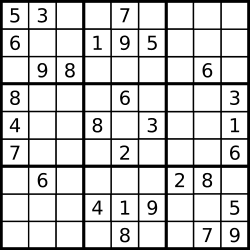Description
Given an unsorted integer array, find the smallest missing positive integer.
Example 1:
Input: [1,2,0] Output: 3Example 2:
Input: [3,4,-1,1] Output: 2Example 3:
Input: [7,8,9,11,12] Output: 1Note:
- Your algorithm should run in O(n) time and uses constant extra space.
使用O(n)的时间复杂度和O(1)的空间在无序数组中查找第一个缺失的正数。
 A partially filled sudoku which is valid.
A partially filled sudoku which is valid.